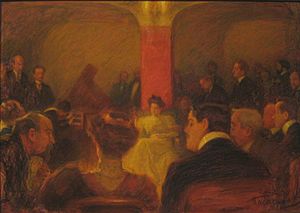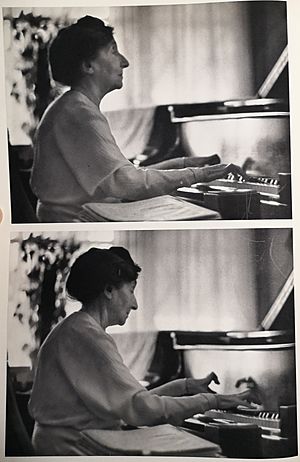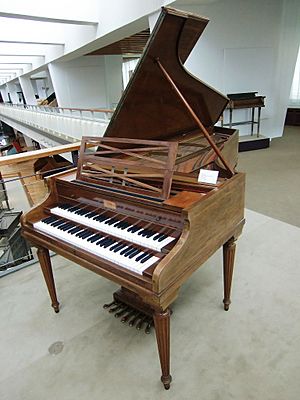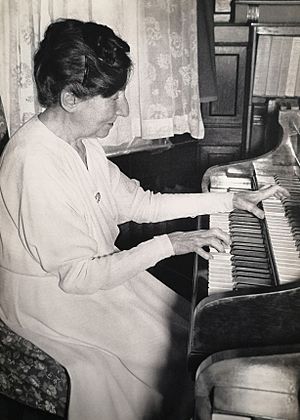Wanda Landowska facts for kids
Quick facts for kids
Wanda Landowska
|
|
|---|---|

Wanda Landowska in 1937
|
|
| Background information | |
| Birth name | Wanda Aleksandra Landowska |
| Born | 5 July 1879 Warsaw, Poland |
| Died | 16 August 1959 (aged 80) Lakeville, Connecticut, United States |
| Occupation(s) |
|
| Instruments | Harpsichord |
Wanda Aleksandra Landowska (born July 5, 1879 – died August 16, 1959) was a famous Polish musician. She played both the piano and the harpsichord. Wanda Landowska was very important in bringing the harpsichord back into popularity in the early 1900s.
She was the first person to record Johann Sebastian Bach's famous Goldberg Variations using a harpsichord in 1933. Later, in 1938, she became a citizen of France.
Contents
Who was Wanda Landowska?
Early Life and Musical Start

Wanda Landowska was born in Warsaw, Poland. Her father was a lawyer, and her mother was a linguist who translated books into Polish. Wanda started playing the piano when she was just four years old.
She studied music at the Warsaw Conservatory. People thought she was a child prodigy, meaning she was incredibly talented at a young age. She also studied music in Berlin and Paris.
Choosing the Harpsichord
Wanda began her career performing in Paris. Critics praised her concerts. By 1903, she started including works by Johann Sebastian Bach for the harpsichord in her shows.
Even though she was a promising pianist, she decided to focus on the harpsichord. Her friends thought she should stick with the piano, but Wanda followed her passion.
In 1900, she married Henry Lew, a Polish expert in folklore. She taught piano at the Schola Cantorum in Paris from 1900 to 1912.
Teaching and Touring
Later, she taught harpsichord at the Berlin Hochschule für Musik from 1912 to 1919. During World War I, she was held because she was a foreign citizen. After the war, her husband died in a car accident.
In 1923, Wanda performed in the United States for the first time. She toured major cities with four special harpsichords made by Pleyel. These instruments were very large and had foot pedals, similar to a piano.
Wanda was very interested in musicology, which is the study of music. She loved the works of Bach, Couperin, and Rameau. She visited museums across Europe to see old musical instruments. She even bought old instruments and had new ones built for her.
When another musician, Pablo Casals, criticized her way of playing Bach, she famously said: "You play Bach your way, and I'll play him 'his' way." This showed her strong belief in playing music as it was originally intended.
Some important new musical pieces were written especially for her. For example, Manuel de Falla's El retablo de maese Pedro brought the harpsichord back into modern orchestras. Francis Poulenc also wrote his Concert champêtre for her.
She taught at the Curtis Institute of Music from 1925 to 1928. In 1925, she started her own music school in Paris called the École de Musique Ancienne. From 1927, her home became a place where old music was performed and studied.
Moving to America
When the German Army invaded France, Wanda Landowska left with her student and close friend, Denise Restout. They left their home in 1940 and sailed from Lisbon to the United States.
Wanda thought the war would be short, so she only took two suitcases. She arrived in New York on December 7, 1941, the same day as the attack on Pearl Harbor. Her home in France was robbed, and her instruments and music papers were stolen. She arrived in the U.S. with almost nothing.
In 1942, she performed Bach's "Goldberg Variations" in New York. This was the first time in the 20th century that this piece was played on the harpsichord, the instrument it was written for.
She settled in Lakeville, Connecticut in 1949. She became a well-known performer and teacher in the United States, touring a lot. Her last public performance was in 1954.
Her friend, Denise Restout, helped edit and translate Wanda's writings about music. These writings were published after Wanda passed away.
Wanda Landowska made many recordings for companies like Victor Talking Machine Company/RCA Victor and The Gramophone Company/EMI.
Famous Recordings
Wanda Landowska recorded many important musical pieces. Here are some of her most famous recordings:
- Bach: Goldberg Variations, French Suite No. 6, Italian Concerto, Concerto No. 1. in D major, Chromatic Fantasia and Fugue, 15 "Inventions for two voices"
- Couperin: Les Barricades mystérieuses, Le Rossignol en Amour
- Handel: Harmonious Blacksmith
- Mozart: "Coronation" Concerto K 537 for piano and orchestra, Turkish march, Rondo in K 485
- Rameau: La Dauphine, Le Tambourin, La Poule
- Scarlatti: Many Sonatas
Musical Compositions
Besides performing, Wanda Landowska also composed her own music. Some of her works include:
- A serenade for string instruments
- Music for women's voices and orchestra
- "Hebrew Poem" for orchestra
- Polish folk songs for different instruments and voices
- Over a hundred songs for voice and piano
- Cadenzas (solo parts) for Mozart and Haydn concertos
Writings and Legacy
Wanda Landowska wrote a book called La Musique Ancienne (Old Music) in 1909 with Henry Lew. Her writings on music were later collected and published as Landowska on Music after she died.
Her work helped many people rediscover the beauty of the harpsichord and early music.
See also
 In Spanish: Wanda Landowska para niños
In Spanish: Wanda Landowska para niños





